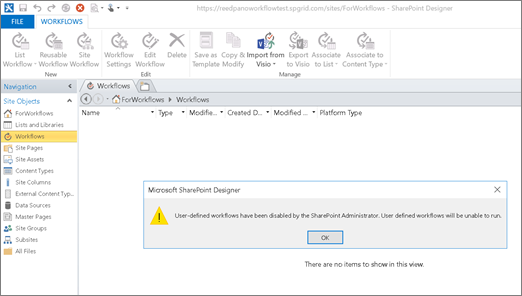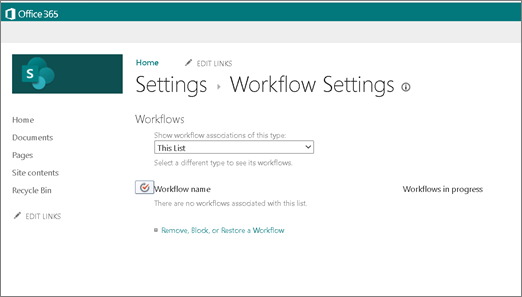As part of the evolution of the Microsoft 365 service, we periodically evaluate the capabilities of the service to make sure that we're delivering the utmost value to customers. After careful consideration, we concluded that for SharePoint 2010 workflows, Microsoft 365 customers would be better served by modern workflow solutions.
SharePoint 2010 workflows have been retired since August 1, 2020 for new tenants and removed from existing tenants on November 1, 2020. This applies to all environments where Power Automate is available as a replacement solution (excluding the Department of Defense until Power Automate availability). If you’re using SharePoint 2010 workflows, we recommend migrating to Power Automate or other supported solutions.
After August 1, 2020, new Microsoft 365 customers can use SharePoint 2013 workflows or Power Automate. However, SharePoint 2013 workflows will follow a similar retirement path in the future, so it's highly recommended to use Power Automate or other supported solutions. You won't lose any content during the transition. However, all migration of workflows is a manual process.
A retirement announcement banner has been introduced on multiple workflow pages:
"Starting 11/1/2020 6:00:00 AM, SharePoint 2010 workflows will be retired and users will no longer have the ability to run or create 2010 Workflows."
Timeline
|
Date |
Action |
|---|---|
|
August 1, 2020 |
SharePoint 2010 workflows will be turned off for any newly created tenants. |
|
November 1, 2020 |
SharePoint 2010 workflow services will be removed from existing tenants. |
Background
In the context of SharePoint, a workflow is the automated movement of documents or items through a sequence of actions or tasks that are related to a business process. An organization can use workflows to attach business logic to documents or items in a SharePoint list or library.
Classic workflows in SharePoint constitute two workflow systems namely:
-
SharePoint 2010 workflow
-
SharePoint 2013 workflow
While both workflow systems allow you to build and publish workflows in SharePoint, below are some of the key differences:
-
SharePoint 2010 workflows, released along with SharePoint Server 2010, are hosted, and executed in the SharePoint workflow runtime
-
SharePoint 2013 workflows, released along with SharePoint Server 2013, are hosted in SharePoint, and executed in the Workflow Manager, which runs independently
Most people use SharePoint Designer to author and publish workflows in SharePoint while professional developers looking to extend and build workflows use Visual Studio to build and publish workflows in SharePoint.
Impact to customers
SharePoint 2010 workflow
Starting August 1st, 2020, SharePoint 2010 workflows will be turned off for any newly created tenants.
Starting November 1st 2020, SharePoint 2010 workflow services will be removed from existing tenants so that no new or existing 2010 workflows will run.
The following built-in workflows will be impacted:
-
Approvals: This workflow routes a document or an item to a group of people for approval.
-
Collect feedback: This workflow routes a document or an item to a group of people for feedback. Reviewers can provide feedback, which is then compiled and sent to the person who initiated the workflow.
-
Collect signatures: This workflow routes a Microsoft Office document to a group of people to collect their digital signatures.
-
Classic pages publishing approval: This workflow is like the Approvals workflow in that it automates the routing of draft pages to subject matter experts and stakeholders for review and approval.
-
Three-state: This workflow helps organizations manage business processes that track a high volume of issues or items--such as customer support issues, sales leads, or project tasks--through three states (statuses).
-
Disposition approval: This workflow manages document expiration and retention by allowing participants to decide whether to retain or delete expired documents.
SharePoint 2013 Workflow
This retirement doesn't apply to SharePoint 2013 workflows. SharePoint 2013 workflows will remain supported, but will be retired at some point in the future; we recommend that you migrate to Power Automate or other supported solutions, such as those from Preferred members of our Microsoft 365 Business Apps Partner Program.
In the near future, SharePoint 2013 workflows will be turned off by default for new tenants. The previous turn-off date of November 1, 2020 has been postponed and a new date has yet to be determined. We will provide a PowerShell script to let you activate the SharePoint 2013-based workflow engine for new environments, as needed.
SharePoint Server support for SharePoint 2010 and SharePoint 2013 workflows
SharePoint 2010 and SharePoint 2013 based workflows will continue to be supported with no modification in our previous support posture and continue to be supported for on-premises SharePoint 2016 and SharePoint 2019 platforms until 2026.
SharePoint Designer 2013
SharePoint 2010 workflow creation and execution against SharePoint Online from SharePoint Designer 2013 will be turned off for any newly created tenants starting August 2020 and existing tenants starting November 2020. Existing workflows can only be viewed as raw XML files.
SharePoint Designer 2013 will work with SharePoint Server 2019 for the remainder of the client support lifecycle (2026). SharePoint Designer 2013 will not be supported beyond that timeframe.
Overall, the general guidance is to mitigate the impact by migrating to Power Automate or other supported solutions.
Guidance
SharePoint Modernization Scanner
To understand if your organization is using SharePoint 2010 workflow or begin planning migration to Power Automate, we recommend that you run the SharePoint Modernization Scanner tool to scan your tenants for legacy workflows usage. The Workflow Report generated by the scanner tool can tell you the following:
-
Distribution of legacy workflows across SharePoint 2010 and SharePoint 2013 workflows
-
Distribution of built-in and custom workflow usage
-
Which sites and lists use workflows
-
Power Automate upgradability score indicating how likely the detected actions can be upgraded to flows with Power Automate
Using the Workflow Report, along with site information, tenant administrators can work with their users to migrate these workflows with minimal interruption.
Use Power Automate with Microsoft 365 license
All Microsoft 365 licenses include usage of the Power Platform for the purpose of customizing and extending Microsoft 365 applications. This includes both Power Automate and Power Apps.
Power Automate also has additional premium features that you can buy on top of your Microsoft 365 licenses. Learn more about the specific features that are included with Microsoft 365 licenses.
User interface updates when SharePoint 2010 workflows is disabled on a tenant
When Workflows 2010 is disabled on a tenant, both SharePoint sites and SharePoint Designer will limit operations when trying to create or interact with a workflow based on Workflows 2010. Below are some of the known issues users can encounter in a tenant where Workflows 2010 is disabled.
-
Any time someone opens a site in SharePoint Designer and tries to perform an action related to SharePoint 2010 workflow (for example, create a new SharePoint 2010 workflow), they'll get the following error:
"User-defined workflows have been disabled by the SharePoint Administrator. User defined workflows will be unable to run."
-
When site collection owners activate the Workflows feature in Site Collection Features in a tenant where Workflows 2010 is disabled, the feature will successfully activate, but it won't install any built-in workflows associated with Workflows 2010.
Users will be able to verify this behavior on the Workflow Settings page where they won’t be able to create a workflow based on Workflows 2010.
Whom do I contact for help with the migration?
You can use the following services and partner programs to help with your migration from SharePoint 2010 workflows:
More information
-
Friendly link to the blog post: https://aka.ms/sp-workflows-update
-
Friendly link to this article: https://aka.ms/sp-workflows-support
-
Friendly link to Migration Guidance: https://aka.ms/sp-workflows-guidance
-
A Message Center post in the Microsoft 365 admin center is being sent to all tenants, and the post will be updated periodically with timelines.










